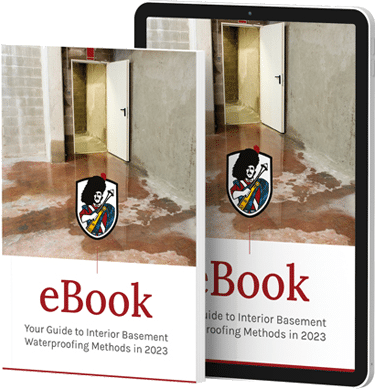A sump pump is a pump used to remove water that has accumulated in a water collecting sump basin, commonly found in the basement of homes. The water may enter via the perimeter drains of a basement waterproofing system, funnelling into the basin or because of rain or natural ground water, if the basement is below the water table level. Sump pumps are used where basement flooding happens regularly and to solve dampness where the water table is above the foundation of a home. Sump pumps send water away from a house to any place where it is no longer problematic, such as a municipal storm drain or a dry well. Pumps may discharge to the sanitary sewer in older installations. Once considered acceptable, this practice may now violate the plumbing code or municipal bylaws, because it can overwhelm the municipal sewage treatment system. Municipalities urge homeowners to disconnect and reroute sump pump discharge away from sanitary sewers. Fines may be imposed for noncompliance. Many homeowners have inherited their sump pump configurations and do not realize that the pump discharges into the sewer.
Usually hardwired into a home’s electrical system, sump pumps may have a battery backup. The home’s pressurized water supply powers some pumps, eliminating the need for electricity at the expense of using potable water, potentially making them more expensive to operate than electrical pumps and creating an additional water disposal problem. Since a sump basin may overflow if not constantly pumped, a backup system is important for cases when the main power is out for prolonged periods of time, as during a severe storm. There are generally two types of sump pumps — pedestal and submersible. The pedestal pump’s motor is mounted above the sump, where it is more easily serviced, but is also more conspicuous. The pump impeller is driven by a long, vertical extension shaft and the impeller is in a scroll housing in the base of the pump. The submersible pump is entirely mounted inside the sump, and is specially sealed to prevent electrical short circuits. There is debate about which variety of sump pump is better. Pedestal sump pumps usually last longer (25 to 30 years) if they are installed properly and kept free of debris. They are less expensive and easier to remove. Submersible pumps will only last 5 to 15 years. They are more expensive to purchase but can take up debris without clogging.
Sump pump systems are also utilized in industrial and commercial applications to control water table-related problems in surface soil. An artesian aquifer or periodic high water table situation can cause the ground to become unstable due to water saturation. As long as the pump functions, the surface soil will remain stable. These sumps are typically ten feet in depth or more; lined with corrugated metal pipe that contains perforations or drain holes throughout. They may include electronic control systems with visual and audible alarms and are usually covered to prevent debris and animals from falling in. Sump basins and sump pumps must be maintained. Typical recommendations suggest examining equipment every year. Pumps running frequently due to higher water table, water drainage, or weather conditions should be examined more frequently. Sump pumps, being mechanical devices, will fail eventually, which could lead to a flooded basement and costly repairs. Redundancy in the system (multiple/secondary pumps) can help to avoid problems when maintenance and repairs are needed on the primary system. When examining a sump pump and cleaning it, dirt, gravel, sand, and other debris should be removed to increase efficiency and extend the life of the pump. These obstructions can also decrease the pump’s ability to drain the sump, and can allow the sump to overflow. The check valve can also jam from the debris. Examine the discharge line opening, when applicable, to ensure there are no obstructions in the line. Even a partially obstructed discharge line can force a sump pump to work harder and increase its chance of overheating and failure.
Float switches are used to automatically turn the sump pump on when water rises to a preset level. Float switches must be clear of any obstructions within the sump. A float guard can be used to prevent the float switch from accidentally resting on the pump housing, and remaining on. As mechanical float switches can wear out, they should be periodically tested by actuating them manually to assure that they continue to move freely and that the switch contacts are opening and closing properly. If left in standing water, pedestal pumps should be manually run from time to time, even if the water in the sump isn’t high enough to trip the float switch, This is because these pumps are incapable of removing all the water in a sump and the lower bearing or bushing for the pump impeller shaft tends to remain submerged, making it prone to corrosion and eventually freezing the drive shaft in the bearing. In the alternative, a pedestal pump that is expected to remain idle for an extended time should be removed from the sump and stored out of water, or the sump should be mopped out to bring the level of the remaining water well below the lower shaft bearing.
Also Read : Sump Pump Installation







